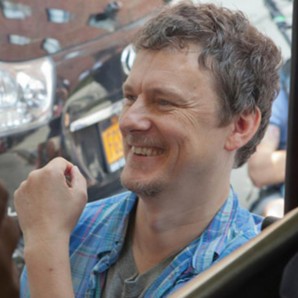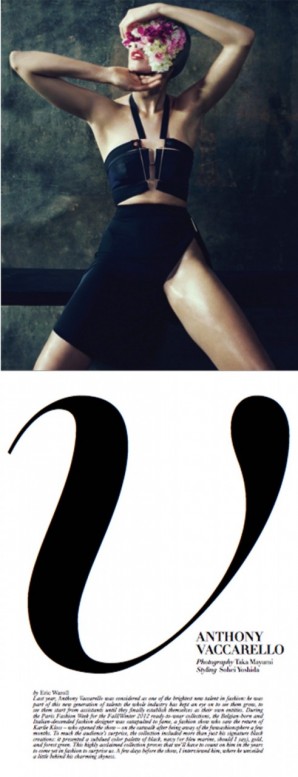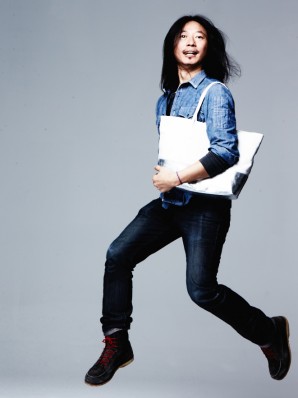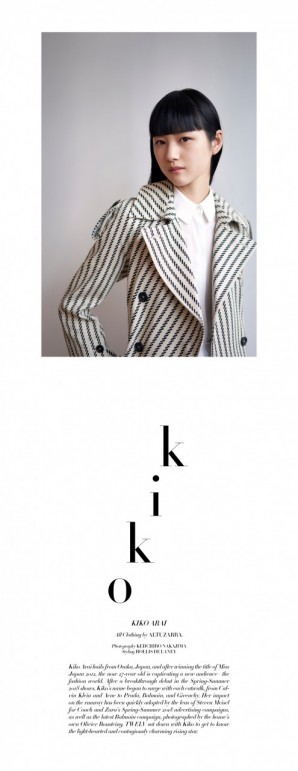TWELV sits down with founders of Parlor Social Club Jan Cieslikiewicz and Frederick Ghartey to give a glimpse into the story of co-founders living in New York City.
Søren Solkær Interview
Stepping out of a cab into the urban symphony of Midtown, the entryway to The Quin Hotel was easy to spot— with classic architecture and bright satin flags swaying slowly in the summer breeze. There was a new exhibit on display called Heartbeat City, featuring photographs of the most recognizable symbols of New York, all with a distinct tone and colorful whimsy. Reminiscent of the iconic screen prints of the 60s, the modern, elegant lobby of The Quin had been transformed into a setting of cosmopolitan celebration. After exploring the lobby display and all of the other art locations throughout the hotel, I was escorted to interview Søren Solkær, the artist behind the dynamic photographs.
Audrey Rose at TWELV: Can you tell me a little more about your exhibit Heartbeat City?
Søren Solkær: Heartbeat City is the title for the whole lobby installation, but it’s mainly inspired by my new work. “Beat City” was the name of the first music video I ever did with The Ravenettes, and part of it was shot in New York. So it goes back to the late 90s or early 2000s. And the “Heart” part came from my love for New York. I’ve come back here maybe forty or fifty times. This image that I did of Nick Walker (also when I came to The Quin for the first time) had the very iconic heart in it, too.
A: What were your main sources of inspiration for the project?
SS: All of the work is done in New York City– whether its a photograph taken from an airplane, one of street artists or some of the most iconic spots in New York, or shots from the 90s. All the photographs are New York, as seen by me, across many projects and during quite a long period of time.
A: What keeps drawing you back to New York?
SS: I’m here a few times every year, and I know the city really well. Not quite like a local, but almost. I’m here that often. I’ve shot a lot in the streets, so I know a lot of the buildings and corners and the different neighborhoods. There’s just nothing like it. If I haven’t visited for 6 months, I find a reason to come back.
A: How have you experienced New York change since you first started coming here?
SS: It’s a good question, because it’s one that I can’t answer very well. I think I’ve changed a lot in the same period. When I started coming here, I was sleeping on friends’ couches. But I’ve always been mainly interested in the art and the street life, and I don’t really know how it’s changed– it’s just always been exciting! It’s always been this unlimited source of inspiration for me.
A: You originally started working as a photographer with Danish rock bands in the 90s. How was that experience?
SS: I started with Danish bands, but after a couple years of photographing in Copenhagen, I started working with English bands. It doesn’t take a long time to get acquainted with all the bands in Copenhagen– it’s a small place– so once I ran out of new exciting bands, I started working in London.
A: And that was when you transitioned from photographing mainly musicians to working more with artists and shooting street photography?
SS: Yes, but I’ve always worked with artists. Before I shot musicians, I did a project where I just photographed photographers. And in this work I photographed forty-five photographers. I’ve always been interested in working with other creatives, whether it be visual artists or actors or musicians.
— D.K. Johnston, the art curator at The Quin, joins the conversation. He sits across from Soren on the couch. After we all take a little break for small talk, we resume the interview.
A: Søren, what is it about The Quin that attracted your attention as an artist? What made this the perfect place to exhibit your work?
SS: It was a place that I started hearing about last year. I had never stayed here in the past, but some friends of mine showed here. I learned about the art program and that The Quin has a special relationship with artists. And then one day, Darren [D.K. Johnston] called me, and that’s really how it all started.
A: Did you have a say in where you wanted your art to be showcased within the hotel? Or was that more of the curator’s expertise?
D.K. Johnston: My hope is to have more and more different fingerprints on the visual process and the experience for the guests, so for someone with the aesthetic and design vision that Soren has, it was really mostly his own perspective on where to place things. We shared the history of different experiments that we’ve tried at the hotel– now that we’re almost to 20 of these solo shows– so it was a good base to work off of layout-wise, too.
SS: Yes, I had a pretty different plan when I arrived the first time, so actually it was something that developed over time, which made it really custom-made for the space. And the opportunity came up to show some work in the penthouse, and suddenly the hotel opened up even more, which was great.
A: You cite pop art as a source of influence for Heartbeat City, and we’ve seen pop art in its purest form shift towards something that’s more mass produced and used across immense media platforms. What are your thoughts on this evolution?
SS: I suppose it was pretty shocking when Andy Warhol did it, because he was using commercial printing techniques to create art– and that was shocking. But now I think it’s been absorbed, especially by street artists. Almost every other street artist has a studio practice as well, so these print-making techniques have really become part of it. Of course you can see Warhol’s fingerprints all over today’s art world even though it was many decades ago that he started doing it. I had a few different ideas for this new project about New York, but I ended up not going the printing way. Instead I did these multiple exposures that had been inspired by pop art prints, but using my camera.
DK: When I start to hear pop art tossed around in a dialogue on street art, my aspirations lean towards tying the two movements together. A lot of street artists have the same challenges that pop artists faced in the 60s, 70s and 80s– challenges of defining a movement. I tend to find that the same players in the movement have little to do with each other as artists, other than that they were alive at the same time. And street art struggles with that same kind of loose connectivity. There is a vast amount of nuance. This art is all collected and sold by the same group of people and followed by the same group of admirers. And pop art had this too, and it took a long time to formulate a valuable market around it. I think in street art, you have a movement that was born out of graffiti, and you have writers on that side like TAKI 183 or Cornbread who really have no commercial viability, but every person in the graffiti industry has to tip their cap to them for opening up the door. And I think that Soren has helped memorialize a lot of these artists.
A: Do you see politics as a major driving force in the street art community?
SS: They are driven by many many different things. Some are more aesthetics. Some are more political. Some are ego-driven. There are some artists that if you go into a certain kind of bar, be it in Prague, London, New York, you know you’ll find their stickers in the toilet. Say with Shepard Fairey and Obey, his stickers are found everywhere.
DK: And a lot of that is his tribe. His admirers buy his stickers and they’re proliferating his ideas. It’s pretty interesting. I’ve been working with all these artists and representing them for many years, and Soren has photographed many of them. This continuity and now being able to share the backstories and evolution has been a lot of fun. But the hope of trying to memorialize what’s going on here has been a real challenge, and Soren took on that challenge over a long period of time and did such a thoughtful job of telling their stories and capturing their work and the importance of it– I think it’s a cornerstone for the movement.
A: As an artist, what kind of impression do you want to make on people when they see your work?
SS: When we first talked about what I would show here, it wasn’t going to be work based on New York. It would be bringing another part of the world to this hotel to show what it’s like there. But, I felt like it made more sense to showcase New York because people staying at this hotel are from everywhere in the world. And at least while we’re all staying here, this is what we have in common. I wanted to offer my view and love for the city. That’s what I wanted to share.
DK: When we got started, we wanted to focus on celebrating the art heritage here. I compare it to the difference between hanging up taxidermy trophies and actually wanting to live with animals. You can hang cool art on the walls, but if you really want to feel like the creative class is here, then they have to be here. It’s a delicate balance. We really wanted to live with giraffes and rhinos and art in its natural habitat, and we’ve done it. The artists that work with The Quin interact with the guests and are involved in a lot of the events. That’s a level of authenticity that you don’t often see.
A: Both street artists and musicians often have reputations for their somewhat volatile personalities. How has your experience been working in such close collaboration with them?
SS: After having worked with musicians for so many years, I eventually worked with most of the ones I wanted to work with. And I also found that it was getting harder and harder to express myself in music photography, because there was more and more control. The higher you get, the more restrictive it is. Suddenly, there would be people at shows making sure you were where you were supposed to be and that just doesn’t interest me. The reason I started doing music photography was because I thought I had a lot of creative freedom there, but I felt like it had become very commercialized and controlled. During those years, street art started popping up everywhere. I started seeing all these great murals going up, and I started recognizing the work and recognizing the names, but I would know nothing about the artist. It’s so different from other art forms, because you don’t know what the artist looks like– you don’t know them. So I felt like this was the new place where the rock n’ roll types would go and express themselves. And I was right. The street artists are twenty times more rock n’ roll than the rockstars.
A: Was it challenging to transition into the street art world?
SS: In street art, at first, no one knew who I was. Basically I wanted to get back to creative freedom and creative collaboration. And that’s whats been really wonderful about this project. I’ve gotten to work with some amazing people with great ideas and crazy energy. And they’re up for anything. The second artists I shot for this project was like, “No, my face can’t be in there!” and I had never thought about that before. So, I had to find a new way of doing it, and the fact that so many street artists didn’t want their faces in the frame became a creative obstacle. But it made this project more interesting.
A: So you went from music to the new rock n’ roll, which you feel is street art. What do you think will be the new new rock n’ roll?
SS: Probably the not-so-established street artists. Things change when you get established, but I think the difference between going into a rehearsal with three guys and doing illegal work at night on a roof, risking your life and your freedom, to tell the world your name or about your dreams– I think it’s a much wilder thing to do than get a hit on the radio.
A: How do you think this style of photography, capturing street artists, will change in the future?
SS: I’ve done almost all of the shoots out on my own, just me and the artist, with maybe my girlfriend filming. And that was it. It was super simple. And it’s very likely that it won’t be possible to do that in 5 years. An army of photographers want to come up with the artists in the lift when they’re trying to finish the wall. Street artists are becoming stars, so it’s changing for sure. I think it’ll be harder to do what I’m working on in the future, but that’s the beauty of it, too. It happens in the streets. Anyone can go out and talk to the artist. And I think that’s pretty cool.
Edited for length and clarity.
WRITTEN BY AUDREY ROSE
EDITED BY HOLLIS DE LANEY
SPECIAL THANKS: BURNS PATTERSON AND THE QUIN HOTEL
PHOTO CREDIT: SØREN SOLKÆR
related posts
Keiichiro Nakajima interview
Keiichiro Nakajima is a photographer and director based in Japan, represented by a management and production company called Signo, Inc, which is one of the largest and leading artist management...
SHIN FUJIYAMA Founder of Students Helping Honduras INTERVIEW
Japanese-American philanthropist Shin Fujiyama co-founded Students Helping Honduras with his sister Cosmo Fujiyama.
NEW TYPE #36: Mônot - ELI MIZRAHI INTERVIEW
Beginning with his childhood in Lebanon, Eli Mizrahi garnished inspiration from across the globe to debut his evening wear brand, Mônot, last fall.
RMK CREATIVE DIRECTOR: KAORI INTERVIEW
KAORI is a renowned make-up artist and the creative director of RMK beauty, a flourishing Japanese makeup and skincare brand that is now sold worldwide.
MICHEL GONDRY INTERVIEW
“MAYBE WE CAN BE IMMERSED IN MOVIES BECAUSE WE’RE USED TO DREAMING.”
JEAN PAUL GAULTIER EXCLUSIVE INTERVIEW
It has become almost useless and banal to introduce Jean-Paul Gaultier.The mere mention of his name alone elicits a constellation of images that have become part of our mind and imagination since...
NEW TYPE #35: DARA SENDERS INTERVIEW
Dara Senders, the designer behind the eponymously titled, all size inclusive brand that launched in 2018, has always been obsessed with fashion.
NEW TYPE #35: NTTE HATS
From a small city near Milan to Downtown New York, Paolo, Designer and creater of NTTE Hatsdiscovered his passion for hats and anything vintage at a young age.
NEW TYPE #34 : BEAU WATSON
1. As a new designer, how do you hope to distinguish yourself among other designers?
NIAN FISH INTERVIEW
Nian Fish, creative director of KCD, has been, for decades, a pivotal figure in the fashion world, assembling and producing fashion shows that have become cultural benchmarks unto themselves, such...
CESAR LOVE ALEXANDRE INTERVIEW
Cesar Love Alexadre is a duo of visual artists formed by Isabelle Chaput and Nelson Tiberghien.They met at the Gobelins school of Photography in Paris and now based in New York where they work on...
TOM PECHEUX INTERVIEW
TWELV got a special interview from Tom Pecheux. Read as we host interviews and explore the lives of artists who shape the final product - directors, fashion designers, stylists, ...
ANTHONY VACCARELLO INTERVIEW
Anthony Vaccarello was considered as one of the brightest new talent in fashion: he was part of this new generation of talents the whole industry has kept an eye on to see them grow, to see them...
Why is Everyone in Hollywood Buzzing About Actress Malgosia Garnys?
Have you ever felt like you were beautiful and powerful and the universe was conspiring in your best interest, and your opportunities were endless because you’ve lost people you loved...
INTERVIEW: Bigwig Broadway Producer, Jordan Roth and Acclaimed Choreographer, Michelle Dorrance
R.I.P Chek Wu
We at TWELV are deeply saddened to announce the passing of talented photographer, boundless free-spirit, and our friend, Chek Wu.
GatherNYC: Everything We Love About Church With No Weird Stuff
GatherNYC is Everything We Love About Sunday Service With None of the Weird Stuff
NEW TYPE #33: Catherine Casias Inteview
If fashion is an expression of experiences, Catherine Casias has a lot of area to cover. She has excelled as an Olympic volleyball player, a philosophy major, and a fine artist....
Party Czar Carmen D’Alessio, Empress of the Sun and the Queen of the Night
You may not know Carmen D’Alessio by name.
IKEMEN #39: JORDAN HENRIQUEZ
IKEMEN (ē´k´mɛn): Japanese Slang
"REALLY, REALLY, RIDICULOUSLY GOOD LOOKING PEOPLE"
IKEMEN #38: WARREN KAY
IKEMEN (ē´k´mɛn): Japanese Slang
"REALLY, REALLY, RIDICULOUSLY GOOD LOOKING PEOPLE"
NEW TYPE #32: ALEXANDER ROYS INTERVIEW
"Introducing an innovative Men’s designer to inspire you with the visions of future and the rise of technology."
Branding in the Worlds of Art and Commerce According to Silvia Mella
Branding is everything. For an entrepreneur, it is the difference between viability and bankruptcy. On social media, we are all our own brands.
Interview: Jackie Yang, Creative Director of Chelsea and Walker
TWELV sat down with Jackie Yang, Creative Director of Chelsea and Walker, in the brand’s New York City...
New Type #31: Angela Mitchell – Krystal and Marilyn Lavoie Interview
We are living in the age of fast fashion, and even Europe’s most storied luxury brands have been moving their factories to Asia to reduce costs.
Ikemen #37: Dominik Halas
IKEMEN (ē´k´mɛn): Japanese Slang
"REALLY, REALLY, RIDICULOUSLY GOOD LOOKING PEOPLE"
New Type #30: Carolina Sarria & Bianca Allen Interview
Both Carolina Sarria and Bianca Allen knew they wanted to become fashion designers from a young age.
Interview & Backstage: Christian Siriano Celebrates 10 Years in Fashion
After the successful launch of his book Dresses to Dream About, a decade-anniversary celebration on the runway, and a whirlwind of striking celebrity looks on the red carpet of...
New Type #29: Jackie Astier Interview
Astier places its identity within the advanced adaptation skills of the modern New York woman.
INTERVIEW: Meet Kiko Arai, Miss Japan-turned Face of Balmain and Zara
Kiko Arai hails from Osaka, Japan, and after winning the title of Miss Japan 2012, the now 27-year old is captivating a new audience– the fashion world.
Interview: Parisian Designer Frédéric Robert's Debut Shoe Collection "ME.LAND"
A vibrant brand of Italian-made shoes for men is emerging this year as one-to-watch.
New Type #28: the Design Duo Behind Maxime Hernandez Interview
The streetwear phenomenon in the fashion establishment is not slowing down anytime soon.
MICHEL NAFZIGER INTERVIEW
With a wealth of experience shooting some for some of fashion's most renowned clients (Yves Saint Laurent, Guy Laroche), ...
IKEMEN #36: Jérôme LaMaar
IKEMEN (ē´k´mɛn): Japanese Slang
"REALLY, REALLY, RIDICULOUSLY GOOD LOOKING PEOPLE"









































